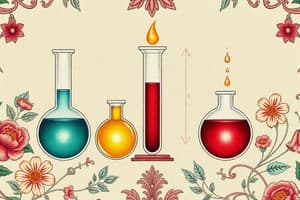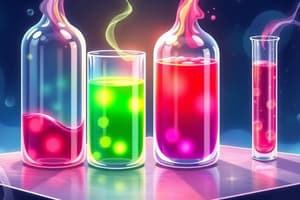Podcast
Questions and Answers
Which indicator can be used to determine the strength of acidic or alkaline solutions?
Which indicator can be used to determine the strength of acidic or alkaline solutions?
- Methyl orange
- Litmus
- Universal indicators (correct)
- Phenolphthalein
What color change does methyl orange undergo in acidic conditions?
What color change does methyl orange undergo in acidic conditions?
- Yellow to Green
- Purple to Red
- Orange to Pink (correct)
- Colorless to Pink
Which pH value indicates a strongly alkaline solution?
Which pH value indicates a strongly alkaline solution?
- 11.1 (correct)
- 6.6
- 8.5
- 7.0
In which field is pH testing critical for soil improvement?
In which field is pH testing critical for soil improvement?
Which of the following indicators would show a colorless result in neutral solutions?
Which of the following indicators would show a colorless result in neutral solutions?
What pH value indicates a diluted hydrochloric acid solution?
What pH value indicates a diluted hydrochloric acid solution?
How do universal indicators differ from common acid-base indicators?
How do universal indicators differ from common acid-base indicators?
Which of the following shows the pH value of human blood?
Which of the following shows the pH value of human blood?
Flashcards are hidden until you start studying
Study Notes
Common Acid-Base Indicators
- Common indicators include litmus, methyl orange, and phenolphthalein.
- Indicators signal whether a solution is acidic or alkaline but do not determine strength.
- They change color sharply at specific pH values, allowing limited differentiation; for example, methyl orange changes between pH 3-4.
Universal Indicators
- Universal indicators encompass mixtures of organic dyes, like pH paper or solutions.
- These indicators assess the strength or pH range of a solution.
- They can differentiate between acidic and basic solutions, yielding various colors for different pH levels, such as shifting from blue to indigo to violet between pH 7 and 14.
Color Changes by Indicators
- Litmus: Purple in neutral, red in acidic, blue in alkaline, pH range from 0 to 14.
- Methyl Orange: Orange in neutral, pink in acidic, yellow in alkaline; transitions from red to violet across various pH levels.
- Phenolphthalein: Colorless in acidic, pink in alkaline, varies between strongly acidic to strongly alkaline.
- Phenolphthalein (alkaline): Remains pink in alkaline solutions, colorless in acidic.
Utility of Indicators by Field
- Agriculture: Soil pH testing aids crop growth; e.g., citrus fruits prefer slightly alkaline soil.
- Dairies: A decrease in milk pH from 6.6 signals souring.
- Technology: Controlled pH is essential for biochemical and organic reactions.
- Medicine: pH assessments of urine and blood assist in diagnosing diseases.
pH Values of Common Substances
- Acidic Solutions:
- Dilute hydrochloric acid: pH 1.0
- Dilute sulfuric acid: pH 1.2
- Acetic acid (vinegar): pH 2.9
- Tartaric acid (grapes): pH 3.5
- Lactic acid (milk): pH 6.6
- Alkaline Solutions:
- Human blood: pH 7.3
- Albumin (egg): pH 7.9
- Sea water: pH 8.5
- Ammonium hydroxide: pH 11.1
- Sodium hydroxide: pH 13.0
Studying That Suits You
Use AI to generate personalized quizzes and flashcards to suit your learning preferences.



